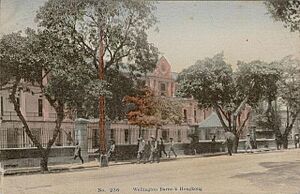Wellington Barracks, Hong Kong facts for kids
Quick facts for kids Wellington Barracks |
|
|---|---|
| 威靈頓兵房 | |
| Hong Kong | |
|
Location within Hong Kong
|
|
| Coordinates | 22°16′41″N 114°09′58″E / 22.278°N 114.166°E |
| Type | Barracks |
| Site history | |
| Built | circa 1850 |
| Built for | War Office |
| In use | 1850-1990 |
Wellington Barracks (Chinese: 威靈頓兵房) was a place where soldiers lived and trained. It was a military base in Admiralty, Hong Kong. The British Army built many military buildings in this area. In the 1970s, the land was given back to the Hong Kong government. The barracks closed around that time. It was torn down in the mid-1980s. Today, a park called Harcourt Garden stands where the barracks used to be.
Contents
A Look Back: The Story of Wellington Barracks
First Hospital on the Land (1841)
The British took control of Hong Kong in 1841 during the First Opium War. A year later, Hong Kong Island officially became theirs. The new leaders decided to use the land near Government Hill for military purposes.
In 1841, the British Army built a hospital there. It was called the Naval and Military Hospital. But just six months later, a big typhoon hit Hong Kong. The storm completely destroyed the hospital.
Wellington Battery: A Fortified Spot
By 1842, maps already showed a "Battery of 5 Guns" in this area. A battery is a place with many cannons. From 1854, it was called "Wellington Battery." This name honored Arthur Wellesley, 1st Duke of Wellington, a famous British general. The battery stopped appearing on maps after the 1900s.
The Barracks: A Busy Military Base
Wellington Barracks was one of several military buildings in Admiralty. Others included Murray Barracks and Victoria Barracks. The barracks was once right on the waterfront of Victoria Harbour. A seawall protected it from the sea. Today, the area is much farther inland. This is because a lot of land has been added to the coast over the years.
The Wellington Barracks was connected to Victoria Barracks. Cables ran between them across Queensway. These cables helped move ammunition between the two bases.
The Golden Clock
In 1890, a large clock was put on the main building. This clock helped everyone at the base keep time. The clock was so important that it gave Wellington Barracks its Chinese name, "Gum Jung Ping Fong." This name means "Golden Clock Barracks." The Admiralty MTR station also got its Chinese name (金鐘) from this famous clock.
In 1910, Wellington Barracks got electricity for the first time.
After World War II ended in 1945, the Royal Navy took over the barracks. They set up their naval base, HMS Tamar, there.
The Barracks and City Growth
As Hong Kong grew, the barracks became a problem. It split the city into two parts: Central and Wan Chai. New buildings could not be built on the barracks land. This meant that new shops and homes had to be built only to the east, in Queen's Road East.
The Government of Hong Kong tried many times to get the land back. They wanted to connect the two parts of the city. But the military did not want to give it up.
In 1959, the Hong Kong Government paid HK$24 million. This was to get back the land where the Wellington Battery used to be.
Finally, in the late 1970s, the military agreed to give the land back. Both Wellington and Victoria Barracks were torn down in the mid-1980s. A large shopping and office complex called Pacific Place was built on part of the land. It opened in 1990. The area where Wellington Barracks stood is now Harcourt Garden, a public park.
See Also



